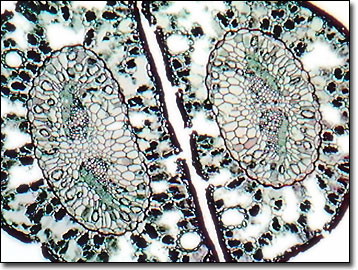Brightfield Digital Image Gallery
Pine Needle Thin Section
Slender green needles projecting in bundles from the branches of pine trees are, in fact, photosynthetic leaves. Pine needles are streamlined and are particularly suited for converting sunlight into life sustaining food even on the coldest of winter days, while minimizing surface area available for evapotranspiration of cellular water during the hot summer months.

Pines (genus Pinus) are commonly called evergreens, because they bear green leaves year-round, continually producing new needles as they gradually drop older ones. The needles form in bundles, spirally arranged along supporting shoots, and this arrangement is a diagnostic characteristic of pines. The number of needles in a bundle is species specific. Pines having two or three needles in a bundle are typically classified as hard pines, whereas soft pines are generally characterized by bundles of five needles.
Native Americans and frontiersmen traditionally harvested the youngest needles toward the end of the branch to produce a mild, red-colored tea that was believed to have medicinal properties. Pine needles gathered from the forest floor, which are made pliable after soaking, are still used to weave baskets. The needles are coiled and stitched into different shapes, and the time-consuming works of art meet Victorian John Ruskin's ideal of combining function with beauty. A pale yellow or milky essential oil extracted from pine leaves is used for massage, and has been thought to possess antimicrobial, antiviral, antiseptic and anti-rheumatic properties, although such claims have not been scientifically proven.
In the American South, fallen pine needles are gathered and bundled into bales and marketed as "pine straw" in a renewable-resource industry. The dried needles are used in landscaping and vegetable gardens as mulch for conserving soil moisture, as an insulator for fragile plants in the winter, and for retarding weed growth. For a number of acid-loving crops such as blueberries, the addition of pine needles increases fruit yields. Some ranchers, in an attempt to achieve increased beef production and fewer calf stillbirths, have resorted to aversion behavior therapy to wean their cattle away from grazing on green and dry pine needles.
Contributing Authors
Cynthia D. Kelly, Thomas J. Fellers and Michael W. Davidson - National High Magnetic Field Laboratory, 1800 East Paul Dirac Dr., The Florida State University, Tallahassee, Florida, 32310.
BACK TO THE BRIGHTFIELD IMAGE GALLERY
BACK TO THE DIGITAL IMAGE GALLERIES
Questions or comments? Send us an email.
© 1995-2025 by Michael W. Davidson and The Florida State University. All Rights Reserved. No images, graphics, software, scripts, or applets may be reproduced or used in any manner without permission from the copyright holders. Use of this website means you agree to all of the Legal Terms and Conditions set forth by the owners.
This website is maintained by our
Graphics & Web Programming Team
in collaboration with Optical Microscopy at the
National High Magnetic Field Laboratory.
Last Modification Friday, Nov 13, 2015 at 01:19 PM
Access Count Since September 17, 2002: 13851
Visit the website of our partner in introductory microscopy education:
|
|
